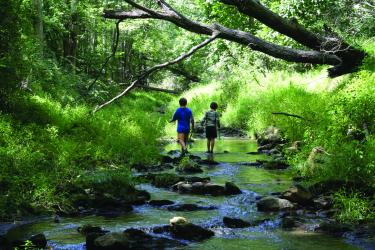How to Care for Streams
Healthy streams aren’t just good for fish, they also help to nourish surrounding vegetation and wildlife, and those of us downstream with clean drinking water. They’re also an attractive feature of the landscape and a source of recreation.
But streams—and the fish, invertebrates, amphibians, reptiles and mammals that rely on them—are under threat in many parts of the country from pollution due to soil runoff, water supply problems, unsustainable forestry practices, and more.
There are three main ways a landowner can care for nearby streams: creating streamside management zones, removing barriers that interrupt a stream’s continuity and maintaining forest roads.
Caring for streams
Streamside Management Zones (SMZs): These fringes of grass, shrubs and trees along stream banks, also known as “riparian buffers,” are one the best ways to protect a water source. Buffers improve water quality by filtering sediment and pollutants from soil runoff and providing shade to keep water cool. They combat erosion by stabilizing banks and regulating stream flow, and they offer a unique habitat to numerous plant and wildlife species. They also benefit landowners directly by improving the aesthetic and recreational value of a property. Streamside fruit- and nut-bearing plants as well as medicinal plants can also be a source of income.
- How: Buffers are usually a mix of native grasses, shrubs and trees, created by seeding and planting. Shrubs such as willows and dogwoods can also be cut and planted into streambanks in early spring. Buffers are usually planned in three zones:
- Zone 1, the streamside zone, stabilizes the bank and provides shade and organic material to the stream. It is typically planted with large trees and shrubs.
- Zone 2 (the middle zone), further inland, helps to slow runoff and absorb nutrients and pollutants. It is often a managed forest or a mix of forest and shrubs.
- Zone 3 (the outer zone), further inland still, slows runoff and traps sediment. It is usually grassland or a mix of grasses and wildflowers. Riparian buffers vary in width, depending on how the adjacent land is being used, but should be a minimum of 25 to 50 feet. The wider the better for improving water quality and attracting wildlife. Learn more about creating riparian buffers—for backyards, woodland and wildlife.
Removing barriers to fish migration: Streams are long, continuous ecosystems. Interruptions to these sinuous ecosystems in the form of bridges and culverts can damage the health of the system by changing stream conditions, such as flow, and preventing the migration of fish and other aquatic species. Native species such a trout, which travel to find cold water, as well as feeding and spawning areas, are particularly vulnerable to barriers.
- How: The most common problems with stream crossings are that they are too small or too shallow. The best way to address this is by building bridges and culverts that are at least 1.25 times the normal width of the streambed and placing them where the stream is straight and flat. Permits are required for most stream crossings. Learn more about impediments to fish passage and how to reconnect streams and rivers.
Road maintenance: Forest roads are a common source of runoff that can be damaging to water quality. In fact, research has shown that 90 percent of the sediment from forested land is due to poorly designed and maintained roads.
- How: When planning roads, landowners should aim to reduce their number, width and length, decrease maintenance requirements and limit their visual and physical impacts. Existing roads should be regularly inspected and repaired by filling wet spots, grading to maintain proper drainage and ensuring ditches and culverts are free of debris. Learn more from this landowner’s guide to forest road construction.
How can I get more tips?
It’s simple! Enter your email below.

